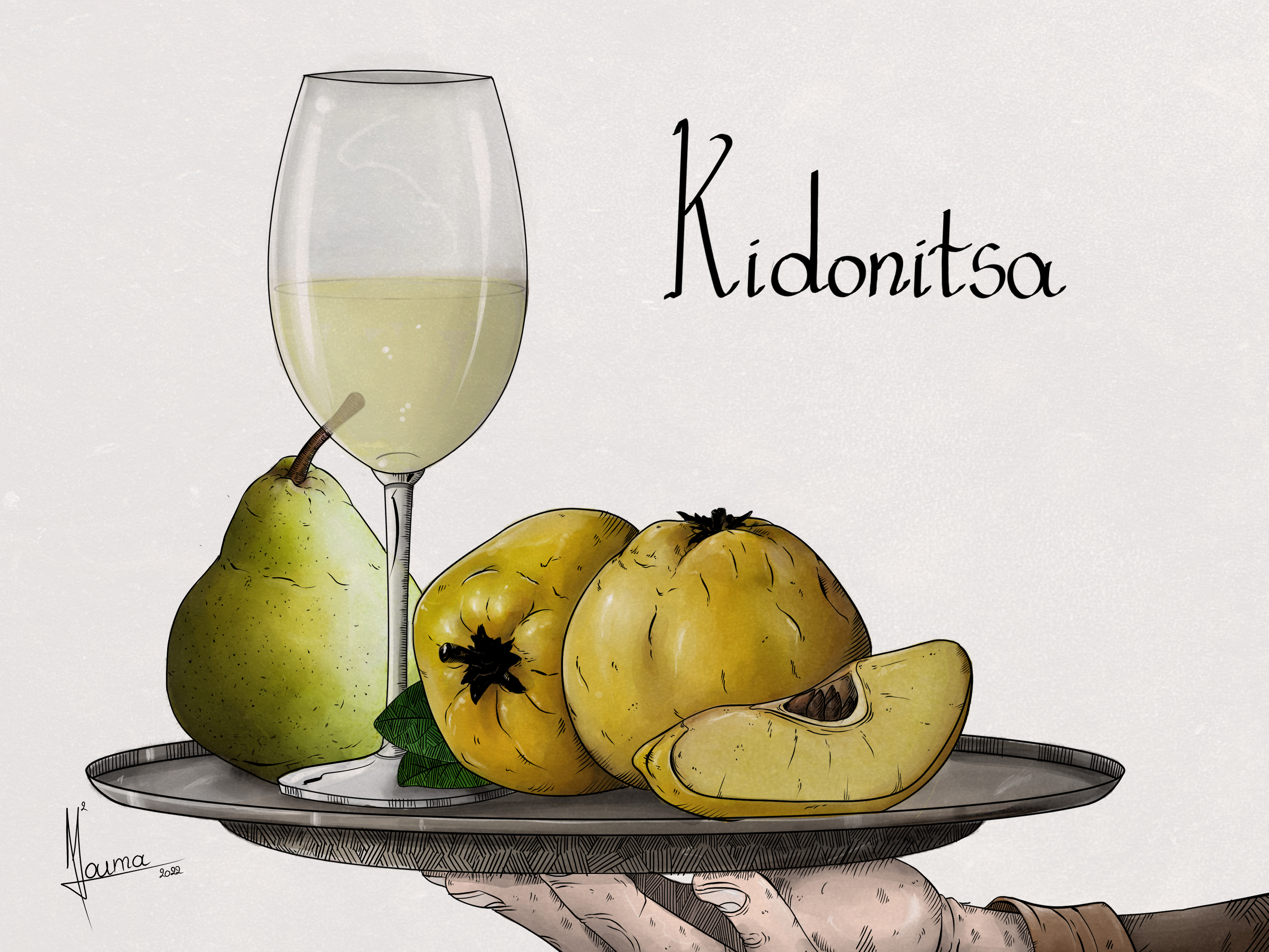
Kidonitsa
By Yiannis Karakasis MW and Evmorfia Kostaki DipWSET
In a nutshell
Kidonitsa, sometimes written as Kydonitsa and (pronounced “ki – dho – NI – tsa”) is a white indigenous Greek grape variety primarily found in the southern part of Greece. Its name likely comes from “kidoni”, the Greek word for quince, which the aromas of the grape seem to resemble.
It’s mainly used to produce dry white wines, which can be both single varietal and blends, and it’s also a blending partner of Movemvasia variety in the PDO Monemvasia-Malvasia for sweet wines. Today, plantings are concentrated in Laconia, the southern part of Peloponnese, but can also be found scattered in other Greek regions, like Nemea and parts of Northern Greece.
Aromatically quince notes are accompanied by oranges, bergamot, pear, with some minerality and notes of chamomile flowers. At the same time, on the palate, the wines produced are crisp, medium-bodied with medium alcohol. Compared to its alter ego, the Monemvasia grape, which is soft and round, Kydonitsa is vivacious and leaner, often with a tannic bite.
History
According to producer Yorgos Tsimbidis, the variety had a pristine reputation among the elders of the Monemvasia region. Inspired by that, after getting support for his research in 1997, he managed to scout old vineyards of the region hunting Kidonitsa and other forgotten grapes, aiming to create a comprehensive database of the varieties of the Laconia region. Indeed, Kidonitsa vines were found and tested for viral diseases. However, he was not entirely convinced that the variety would be of as high standards the elders were describing, considering the high-quality wine standards of our era. Helped once more by the Greek Wine Institute, he vinified using Kidonitsa grapes. Indeed, the result was very encouraging, and he proceeded to plant a few vines of Kidonitsa every year from 2003 onwards. In 2007, the first commercially viable Kidonitsa vineyard of the Tsimbidis (Monemvasia) winery was produced, while plantings have been on the rise since then, not only for Tsimbidis but producers in Laconia and elsewhere in Greece. (approximately 40-50 ha in Laconia).
Viticultural Characteristics
Propagation material
Since plantings of Kidonitsa have been increasing only in the past 20 years, most vineyards are relatively young. There is moderate commercial interest in the variety now, so there is no active research on clonal selection. Growers collect cuttings from scattered older vineyards or use the Massal Selections provided by nurseries. Therefore, it cannot be guaranteed that the cuttings are virus-free, and different sources likely have different severity levels of viral infections.
Phenological stages
Kidonitsa bursts in late March or early April, and flowering happens either in mid-May for Laconia (Monemvasia Winery Tsimbidis) or early June in Nemea (Papagiannakopoulos). Rain or low temperatures during spring can reduce the success of fruit set and consequently the yields (Antemisaris Nursery, Theodorakos Winery).
In all sources found (Stavrakas Ampelography, Antemisaris Nursery), ripening happens after the 20th of September. Nevertheless, this only seems to be true for the region of Nemea, while in Laconia, harvest starts already in the first week of September (Vatistas Winery, Monemvasia Winery Tsimbidis).
Viticultural characteristics and practices
Overall, Kidonitsa has a low leaf area, so terroirs with good sun exposure and Royat training with VSP (vertical shoot positioning) are preferred. Pruning is short, with two buds per spur, and according to the Fassoulis Nursery, the basal buds have low fertility. The crop can be high since the rest of the buds have high fertility (Bakasietas Nursery), reaching 80 hl/ha in Nemea and the vineyards of Papagiannakopoulos, but less, up to 40 hl/ha, in the organic farm of Tsimbidis in Laconia.
The high yields cause producers of Nemea to green harvest not once but twice, both in early spring and after véraison. The bunches are medium to large, while the berries are medium-sized (Stavrakas Ampelography). The disease sensitivity of Kidonitsa is not high, and in the warm Mediterranean climates where it’s grown, the main fungal disease is oidium, which is easily combatted with sulphur. It is resistant to drought, and that’s why it is well accustomed to the climate of Laconia. Dry farmed vineyards with good ventilation are preferred since they reduce the oidium pressure.
Terroirs
Kidonitsa is a variety from the southern end of Peloponnese’s region of Laconia, expanding all over Peloponnese (Nemea and Ilia). Still, it has travelled in many other Greek areas, including Macedonia (Pella and Thessaloniki) and the Aegean Islands.
Laconia
Laconia is one of the warmest and driest parts of mainland Greece. Located in the south-eastern part of Peloponnese, it played an essential role in the historical Malvasia sweet wines. According to Monemvasia Winery, the dry season lasts from the end of March to the beginning of October, therefore practically during all the vine’s growing season. Winters are mild while summers are hot, sunny, and windy; therefore, a mid-ripening variety like Kidonitsa is well suited to the region. Since the sea surrounds Laconia, northerly winds from the sea cool down the land during the hottest part of the day, helping the vines withstand the heatwaves of August.
Nemea
The climate of Nemea is Mediterranean but cooler than that of Laconia, with about 2000 growing degree days in the central part of the valley. Rainfall is an average of 750 mm per year, with 80% of it falling in the winter period (https://www.karakasis.mw/greek-varieties/agiorgitiko). According to Papagiannakopoulos, wet springs can affect the fruitset of Kidonitsa. Kidonitsa harvest in Nemea is about 15 days later than in Laconia, showcasing the cooler temperatures.
Oenological Characteristics
Upon reception of Kidonitsa to the winery, the grapes are destemmed to avoid any extraction from stem phenolics, leaving the Kidonitsa wines smooth to the palate. Most wineries press right after, but Nikolaou Estate and Zacharias Winery cold soak the grapes for about 10 hours to extract richer aromas.
Yeast selection depends on the producer, with Monemvasia winery preferring cultured yeast to achieve consistent results year over year, while at Nikolaou Estate, ambient yeast is selected. As with most Greek white wines, malolactic conversion is usually avoided, but in Nemea, acidity can be higher than needed, and malolactic conversion is required to bring the wine into balance, although buttery, rich characters are generally avoided using the appropriate lactic acid bacteria strains.
Kidonitsa is sensitive to Oxygen, so fermentation and maturation are usually performed in stainless steel tanks, creating fruit-forward wines. To achieve a fuller body, both Monemvasia Winery and Papagiannakopoulos Winery let the wine stay with the lees for about six months. This also creates a reductive environment, useful for oxidation prone Kidonitsa. On the other hand, wines like Lexis from Zacharias Winery mature in oak for four months, so perhaps in the future, when winemakers are more experienced with this variety, we will see even more experimentation with different styles emerging.
Overall, the dry wines of Kidonitsa have a well-structured palate with bright acidity. On the nose, the aromas resemble quince, oranges, bergamot, pear, with some minerality and notes of chamomile flowers, with tropical fruits at the riper wines.
Sweet wines are also made, blended with the Malvasia grape to create the PDO Monemvasia-Malvasia. It can also be combined with other grapes, like Assyrtiko creating a Peloponnesian dry white blend (Dyo Ipsi Dialogos). In any case, the hot Greek sun enables sun-drying of the grapes to achieve a characteristic luscious sweetness. For sweet wines the alcoholic fermentation stops naturally due to the high sugar concentration, creating wines with 13.5 – 14% alcohol and 180 g/L of sugar, while the acidity can be a stunning 7g/L. Winemaking is oxidative, with oak maturation for about two years and the ability to age in a bottle for several years.
Finally, the most recent experiment of some producers, like Papagiannakopoulos, is sparkling Kidonitsa, using the traditional method. It seems the naturally high acidity of the grape and its delicate aromas are well suited for sparkling wines.
Trends
Producers all over Greece have welcomed Kidonitsa in their portfolio over the past decade. Plantings are still increasing both by wineries, but in Nemea, also by individual growers, and while grape prices are stable for now, increasing demand for the wines of Kidonitsa may cause them to rise soon.
Plantings of Kidonitsa are still small, and almost all the bottles produced are sold in Greece. However, many markets seem interested, like the US, UK, Canada, Belgium and France.
Kidonitsa has experienced many variations in styles. Historically it was used to create naturally sweet wines from sundried grapes, tradition reinstated with the PDO Monemvasia-Malvasia. After its recent growth, it was made into dry wines, fermented, and matured in stainless steel. However, oak-aged wines are coming up recently. The final installation in the portfolio of Kidonitsa wines is, of course, sparkling wines. Perhaps we haven’t even seen the real face of Kidonitsa just yet!
Ageing potential
Most Kidonitsa wines are ready to be enjoyed upon release and can hold up to 3 to 5 years (for the best examples) following the harvest.
Food Pairings
The fresh, inviting, dry wines of Kidonitsa are outstanding by the glass and vegetarian dishes like a traditional spinach pie or dolmadakia (rice with herbs wrapped with vine leaves).
Vintage information
From the most recent vintages, 2017, 2018 and 2020 were particularly successful in Laconia, while 2017 and 2019 were good vintages in Nemea.
Notable producers
Single varietal: Monemvasia, Theodorakakos, Ieropoulos, Papagiannakopoulos, Aslanis, Vatistas, Bairaktaris, Ligas, Zaharias, Gofas, Nikolaou
Blends: Dyo Ipsi, Lacovino



